Here you are riding along and enjoying yourself on your 40-year-old, two-stroke vintage dirtbike and the damned thing quits running.
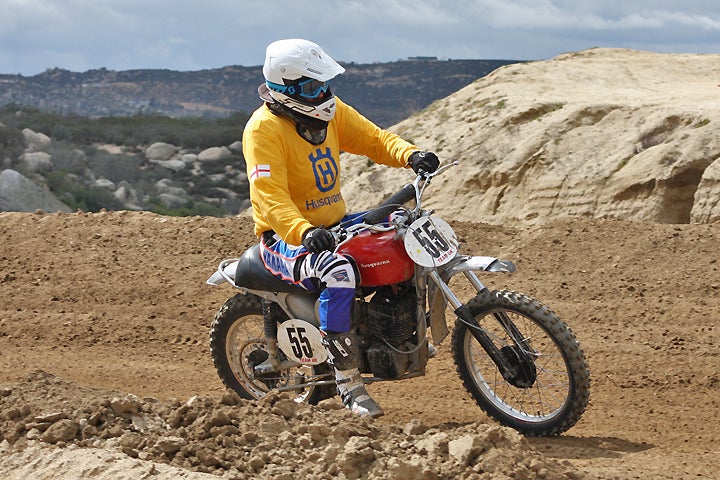
Yup, you’ve got a problem. But you have a little tool bag with you, a few spare plugs and some basic tools; you might be able to get it running again. Bike problems come in two flavors: the bike won’t run at all, or the bike runs poorly. Usually, when the bike runs poorly, you limp home to your truck and try to work on it there.
OUTA GAS?
Let’s say you’re out on the trail and your vintage dirtbike quit running completely. Even worse, when you go to try to start the engine, it won’t start. If the engine fails to start after a reasonable number of kicks, it’s time to do some looking around. First, pop off the gas cap and check for fuel. Don’t laugh. It’s happened the best of them and not only because they forgot to add gas, but because the leak may have developed while the bike was sitting or running. Either way, a vintage dirtbike runs on the stuff same as a modern machine.
Once you have determined that there is indeed fuel in the gas tank, remove the gas line and turn the petcock on. If the gas flows, the trouble is somewhere else. If not, you might have a clogged line or petcock. Dismantling will solve this, but you’re stuck out in the boonies, blowing in the gas line will sometimes temporarily remove the debris.
CHECK THAT PLUG
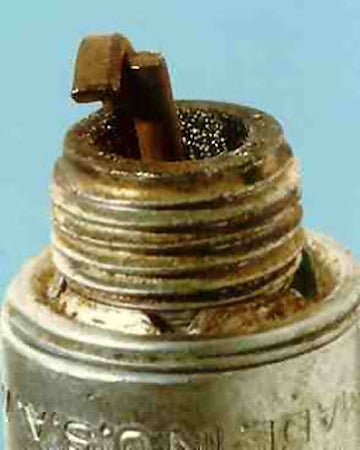
Checking the plug is easy. Remove the plug and look at it closely. If it is clean and dry, ground it against a fin and push the kickstarter through. Watch for a zap at the tip. This should be strong and blue/white. If the plug is weak looking, then it’s almost a timing problem.
Even if you don’t have a lot of with tools you, the offending plug can be reasonably cleaned. The plug tip can be lightly scraped clean against the sharp metal on the bike. A fender tip, engine fin or anything that will fit in there might do the job. You may have to clean the plug, especially if it’s the only one you have. You can clean the plug with most anything. Even a ordinary twig can be run down inside the plug. Attach a piece of lint from your pocket to the twig and you have a first rate plug cleaner. Check the cover on a book of matches; this will give you a ballpark measuring device also, and that striking service makes a good tip cleaner.
Once the plug has been cleaned and you still don’t have a good spark, check the plug wire. All connections should be clean and tight with no corrosion. Checked the other end of the plug wire, and the sleeves on the coil; sometimes vibration loses out proper contact.
If, after all this, you still feel there is no juice running through the spark plug, try the good old acid test. Grab hold of the plug in your bare hand and push the kick starter smartly through. If you’re forced to pick myself up off the ground and say what the hell happened, you better recheck the wire and the plug. The plug itself might have a cracked insulator, or the plug cap might be sloppy loose and faulty. Additionally, check for any moisture around either end of the plug wire or short out in the system. Everything should be clean, dry and tight for strong spark.
WHAT YOUR BIKE NEEDS TO RUN
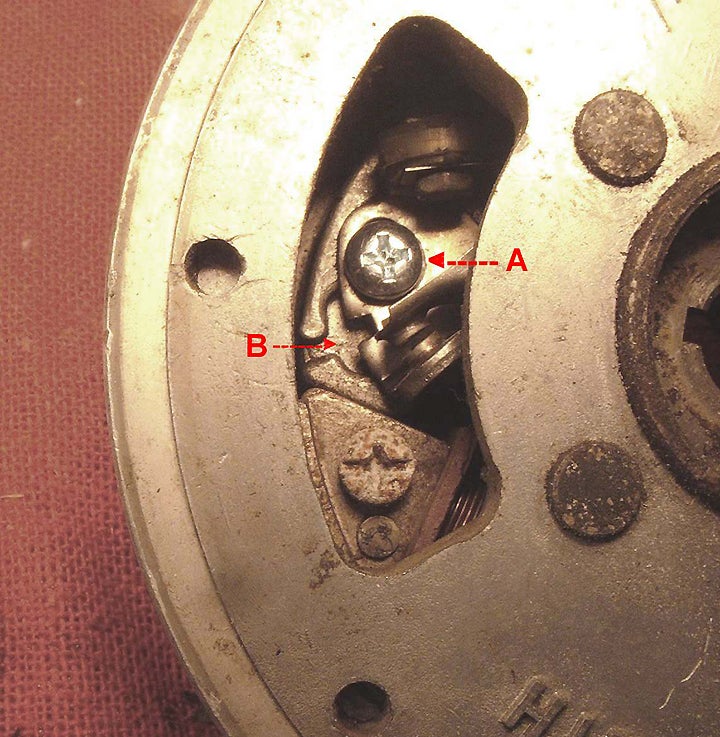
Which takes us back to that old carb. If none of the jets are clogged, the carb is in good working order, gas flow is good and you have a fat spark, the logical place is to look at the points. If a spark is intermittent or weak, it’s almost certainly a point or timing problem.
Most vintage dirtbike models have a flywheel magneto ignition and neither have the points exposed like a CZ or Maico, or the points visible via slot in the flywheel magneto.
Ideally, make a visual check of the contact points. If there is any dirt, oil or grime, this is probably the culprit. Any bad pitting on the points will also contribute to non-running and should be removed.
A dollar bill makes a decent point cleaner. And that book of matches that we talked about earlier is ideal. As the points are thoroughly cleaned, check the gap. This is in any owner’s manual and you should know it, but if you don’t, try 13 to 15 thousandths. That’s generally going to get the bike started and running halfway decently.
Incorrect timing can prevent a bike from a starting. Many riders use an old trick to keep them from going through the entire hassle of dial indicators and whatnot. A small scratch is put on the point plate and run off the mag base. Lining up the scratches should allow the bike to at least run.
A total visual check of the ignition area is a must; anywhere there are frayed and bare wires can short out on an otherwise good system. Loose connections are a distinct possibility. Poke, prod and feel each and every connection and examine each wire, especially when it comes near a metal surface or sharp edge. All wires in the entire system must be checked. It only takes you one small bad contact to prevent the electrical system from functioning.
A good rule of thumb to remember when the bike won’t start, is at least nine out of 10 times, the problem will be electrical. Everyone likes playing with the carb, but that rarely is the case. Just remember: check for gas flow, spark and electrical shorts, in that order.
MOTOR RUNS, BUT RUNS POORLY
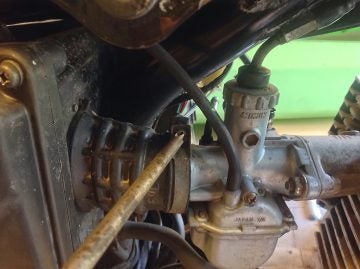
Pay attention to how the motor is running. Does it run just fine for a few moments, then roughly runs the next? Or is it plain ratty all the time? We mentioned fuel early on, and now would be a good time to check it again. The fuel line or gas petcock might be partially blocked. This would allow just enough fuel to let the engine run, but run poorly under any sort of load. Too much fuel can be as bad as too little fuel, resulting in loading up and wet or fouled plugs. A clogged vent on the gas cap can pressurize the gas tank and upset flow. A sticking carb needle will load the bike up with raw gas.
Quite often a stuck float on a vintage dirtbike carb can be remedied by tapping lightly on the flow chamber. This does not mean that you spank that carb to death. Just tap.
Often, a poor running engine can be caused by no real malfunction, but by breathing in preparation for the altitude. A bike that runs great at sea level will fall on its face thousands of feet higher. If you’re going to ride at any appreciable height from normal, carry a selection of jets to compensate for the air density. This should be taken into consideration before you go blindly tearing the bike apart.
We are assuming, of course, that while you are doing all this troubleshooting, the air filter is clean. Many riders wonder why the bike was performing right, only to find out later on it was a filthy filter was slowing the engine to death. You wouldn’t be that dumb, would you?
While we’re on the subject of things that you take for granted, make sure you have the correct spark plug in your vintage dirtbike. Too high a heat range will make the engine run as if it were overly rich; again check your owner’s manual.
We are assuming that the engine is in normal mechanical condition for this troubleshooting session, because worn rings or leaky seals can cause you untold quantities of grief. These things however, don’t happen overnight and are usually of a gradual nature. This guide is for those little things that happen, not for overhauling the entire bike.
Some additional things that people never bother to check when their starts to run weird, are the following all too common bummers. Loose motor mounts and heavy vibration makes the gas in the carb foam. This will give every indication of the poorly adjusted carb and drive you nutty. Check all of the motor mount bolts.
INTERMITENT PROBLEMS
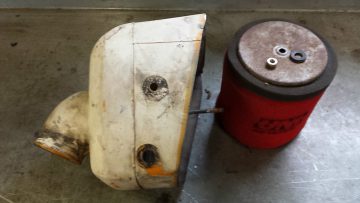
be a problem.
A heavenly carboned vintage dirtbike engine can cause detonation, which is hot particles of falling residue reigniting in post ignition splitting of the fresh charge of gas. Often, crud will accumulate on the plug, get hot and fall off, causing the same thing. Definitely check to see if you’re allowing air to pass at the air cleaner base or air hose for possible air leaks or dirt leaks. These links can allow crud to enter, causing a misfire and then get blown out the exhaust port, leaving a great mystery as to why the engine misfired.
This article was designed with the older bikes in mind. You’ll find that on the newer bikes, the electrical problems are far less. Still, you’ll find that much of what you read here applies. Good riding.
 Your Privacy Choices
Your Privacy Choices